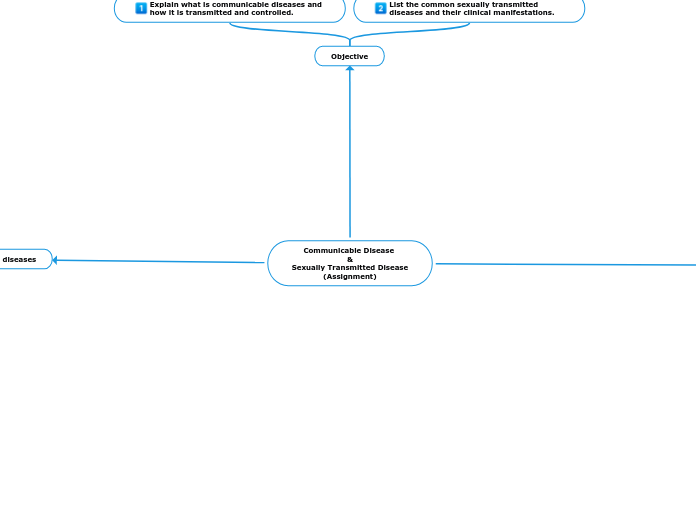af kholood ali 3 år siden
179
Mind Map Assignment
Sexually transmitted diseases (STDs) encompass a variety of infections with distinct clinical manifestations. Common non-HIV STDs include Chlamydia, Gonorrhea, Herpes, and Syphilis.

af kholood ali 3 år siden
179

Mere som dette
Genital tract infection caused by the small obligate intracellular bacterial parasite Chlamydia trachomatis
Chlamydia causes much the same type of inflammation and clinical symptoms as gonorrhea
Chlamydia in females
Chlamydia in males
Caused by herpes simplex virus
Type 2
infects the genital tract, and most infections occur after puberty
Type 1
infects the oral mucous membrane
caused by the gonococcus Neisseria gonorrhoeae
Disseminated Gonococcal Infection
occurs when the sexually transmitted pathogen Neisseria gonorrhoeae invades the bloodstream and spreads to distant sites in the body
Symptoms
skin rash
infections of the joints, tendons, heart valves, and covering of the brain
joint pain
Fever
Gonorrhea in females
fever
pain in the lower abdomin
pain during sexual intercourse
sore throat
heavier periods or spotting
painful urination
discharge from the vagina
Gonorrhea in males
Pain or swelling in one testicle
persistent sore throat
swelling or redness at the opening of the penis
Pus-like discharge from the tip of the penis
Greater frequency or urgency of urination
caused by the spirochete Treponema pallidum
Stages of syphilis
Tertiary syphilis
damage of the brain, nerves, eyes, heart, blood vessels, liver, bones and joints.
- blindness - deafness - mental illness - memory loss - destruction of soft tissue and bone - neurological disorders, such as stroke or meningitis - heart disease - neurosyphilis
granulomatous lesions often found in the skin or bones
Secondary syphilis
Symptoms of secondary syphilis include skin rash, swollen lymph nodes, and fever.
The signs and symptoms of primary and secondary syphilis can be mild, and they might not be noticed.
Primary syphilis
a small ulcer called a chancre develops at the site of inoculation.
Congenital Syphilis
syphilitic mother often transmits the disease to her unborn infant
the infant may be born with congenital syphilis
may cause death of the fetus
Regional lymph nodes often enlarged and tender
Superficial vesicles and ulcers on external genitalia and in genital tract
Infection of rectal mucosa (proctitis)
Pharyngitis
Cervicitis
Urethritis
Tertiary: late destructive lesions in internal organs
Secondary: systemic infection with skin rash and enlarged lymph nodes
Primary: chancre
epidemic
A communicable disease affecting concurrently large numbers of people in a population
endemic
A communicable disease in which small numbers of cases are continually present in a population.
disease is spread from animals to people
control of the animal source of infection also is required
disease is transmitted by insects
eradicate or control the insects that transmit the disease
transmission is by means of contaminated
establishment of effective sewage treatment facilities
chlorination (or similar treatments) of water supplies
Food
Standards for monitoring the manufacture and distribution of commercially prepared foods
control of food handlers
symptoms
Isolation of infected people prevents contact with susceptible people and stops the spread of the disease.
Active immunization
Adjuvant
Substance that enhances an immune response
Exposing a person to a non-infectious pathogen to provoke an immune response.
Passive immunization
Transfer of immunoglobulin from an immunized animal or person to the person to be protected
vector transmission
Biological vector
Malaria
West nile
Lyme disease
Mechanical vector
Shigellosis
Trachoma
Typhoid fever
vehicle transmission
Aerosols
Valley fever
Measles
TB
Water
Cryptosporidiosis
Leptospirosis
Cholera
Foods
Amoebiasis
Hepatitis A
Fomites
Contaminated inanimate object that can transmit disease
Athlete’s foot
Hepatitis B
Tetanus
vertical transmission
Mother to newborn
Neonatal conjunctivitis
gonorrhea conjunctivitis
chlamydia conjunctivitis
Mother to fetus
Congenital syphilis
Listeriosis
horizontal transmission
respiratory droplets
Influenza
Common cold
Pertuissis
sexual intercourse
AIDS (HIV)
chlamydia
syphilis
Gonorrhea
human or animal contact
Ringworm
Rabies
Mumps
Gastroenteritis